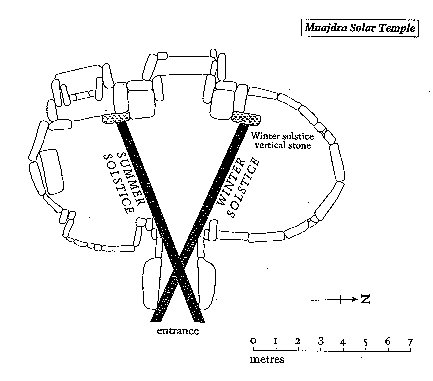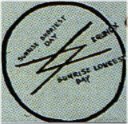|
The picture and
text below is 'illuminating':

"Then I become aware of ... a
presence - a faint, ghostly glimmering, like moonglow, that has
appeared on the solstice stone. I don't know how long it lasts, a
second or two only I would guess, but while it is there it seems
less like a projection - which I know it to be - than something
immanent within the stone itself. And it seems to function as a
herald for it fades almost as soon as it has appeared and in its
place the full effect snaps on - instantaneously. It wasn't there,
and then it's there.
As Chris had described, the
effect does curiously resemble a poleaxe, or a flag on a pole, and
consists of a 'shaft', narrow at the base but widening a little
towards the top, running up the left hand side of the solstice
stone, surmounted by a right-facing 'head' or 'flag'. An instant
later an almond-shaped spot of light, like an eye, appears a few
centimeters to the right of the 'flag' and the effect is complete.
Weirdly - I do not claim it has
any significance - this flag-on-a-pole symbol is the ancient
Egyptian hieroglyph neter, meaning 'god', or 'a god' - and
not to be understood at all in the Judaeo-Christian usage of that
word but rather as a reference to one of the supernatural powers or
principles that guide and balance the universe. Manifested here, in this
strange Stone Age temple, it glows, as though lit by inner fire."
(Hancock 2)
The X form - in slightly different shape, with a central rhomb -
occurs also at the top of the famous trilithon on Tongatapu:

According to tradition it (Ha'amonga-'a-Maui - Burden of
Maui) was 'built by IIth Tui Tonga about 1200 AD
as a gateway to the royal compound. Height 16 ft, width 19 ft,
weight approx 35 tons'.
"During his
coronation year king Taufa'ahau Tupou IV advanced
the theory that the Ha'amonga stones must have served a
greater purpose than the more obvious function as a gateway.
This proved the case when closer investigation revealed a secret
mark on the lintel (= threshold) stone ... On June 21st 1967 at
dawn his majesty was present at this place and it was a
thrilling moment when the sun rose at the exact point indicated
by his interpretation of the lines etched on the great stone."
(Text on a wooden sign at the side of the trilithon. Ref.
Danielsson). |